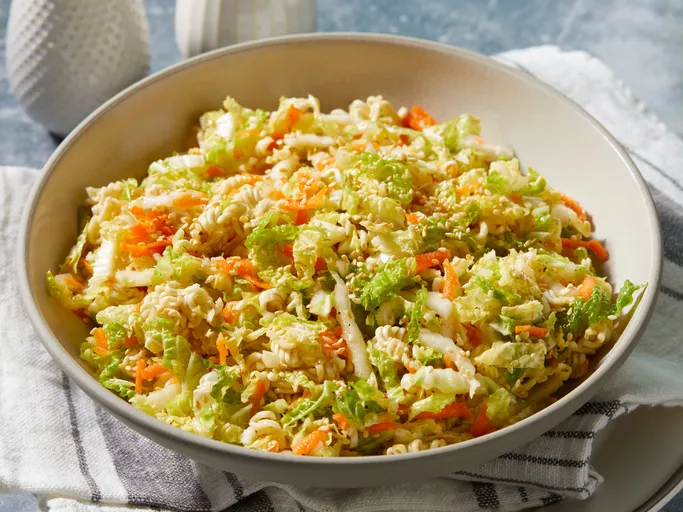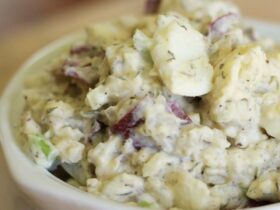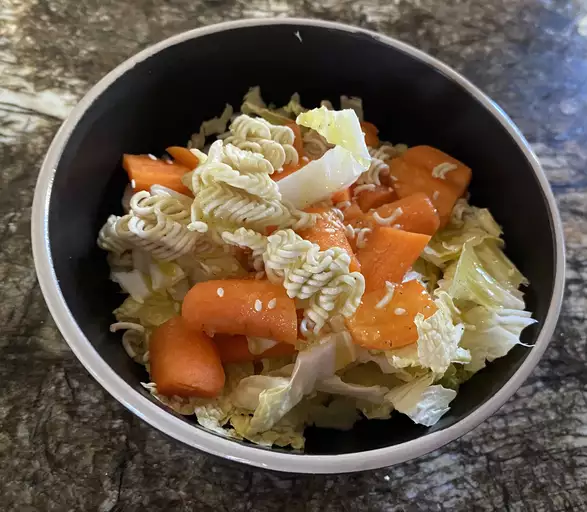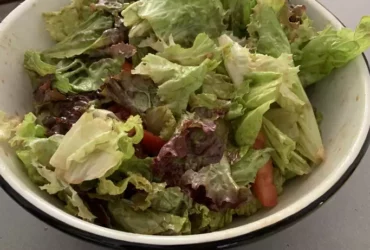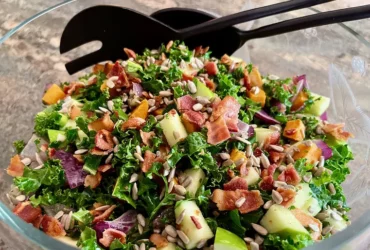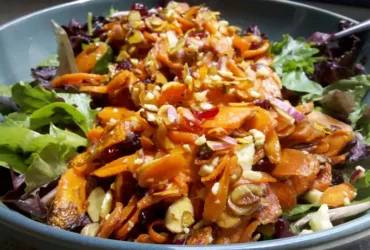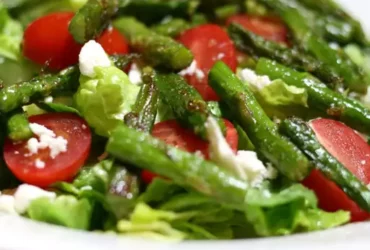Ingredients
Nutrient-Rich Cabbage
Cabbage, a cruciferous vegetable, is a nutrient-rich ingredient that provides numerous health benefits when consumed as part of a balanced diet.
Here are some key nutrients found in cabbage:
- Vitamins: vitamin K, vitamin C, and small amounts of vitamins B6 and folate
- Minerals: potassium, manganese, and smaller amounts of copper and iron
- Antioxidants: isothiocyanates, kaempferol, and quercetin
Cabbage contains various antioxidants that help protect cells from damage, reducing the risk of chronic diseases such as cancer, heart disease, and neurodegenerative disorders.
Some specific health benefits associated with consuming cabbage include:
- Supporting healthy digestion: Cabbage is rich in dietary fiber, which can help regulate bowel movements, prevent constipation, and alleviate symptoms of irritable bowel syndrome (IBS).
- Boosting the immune system: Vitamin C in cabbage helps stimulate the production of white blood cells, supporting the body’s natural defense against infections.
- Reducing inflammation: Isothiocyanates present in cabbage have anti-inflammatory properties that may help alleviate conditions such as arthritis and other inflammatory diseases.
In addition to its health benefits, cabbage is also an affordable, versatile ingredient that can be prepared in various ways, including steaming, sautéing, pickling, or adding it raw to salads like the Asian Cabbage Salad Recipe mentioned earlier.
The Asian Cabbage Salad recipe calls for a variety of ingredients that combine to create a refreshing and flavorful dish. The base of the salad consists of shredded napa cabbage, which provides a crunchy texture and mild flavor.
To add some depth and warmth to the salad, thinly sliced red bell peppers are used. These sweet and slightly smoky peppers complement the earthy sweetness of the cabbage perfectly.
For a pop of color and an additional layer of flavor, chopped carrots are added to the mix. Both the yellow and orange varieties work well in this recipe, bringing a nice balance of sweetness and crunchiness.
To introduce some protein to the salad, sliced cooked chicken is included. This can be seasoned with soy sauce or other Asian-inspired flavors before being added to the salad for extra depth.
For an Asian flair, chopped green onions, toasted sesame seeds, and diced fresh cilantro are used as garnishes. The onions add a pungency that cuts through the richness of the chicken, while the sesame seeds provide a nutty flavor and satisfying crunch.
The salad is then dressed with a vinaigrette made from soy sauce, rice vinegar, sugar, grated ginger, garlic, and chili flakes for an added kick. This dressing not only brings all the ingredients together but also adds a harmonious balance of sweet, sour, salty, and umami flavors.
Finally, to make the salad more substantial, sliced almonds or chopped peanuts are sprinkled on top. These add a satisfying crunch and protein-rich topping to round out this delicious Asian-inspired dish.
The result is a refreshing and flavorful salad that combines the best of Asia’s culinary traditions with a unique blend of textures and tastes. Each bite transports you to the vibrant streets of Bangkok or Tokyo, where every ingredient is carefully selected for its freshness and flavor.
1 head of napa cabbage, thinly sliced (rich in vitamin K and fiber)
The star ingredient in our Asian-style cabbage salad recipe is a single head of napa cabbage, thinly sliced to perfection.
Napa cabbage is a type of Chinese cabbage that belongs to the Brassica family, which also includes broccoli and kale.
It’s prized for its delicate flavor and crunchy texture, making it an excellent choice for salads, slaws, and other Asian-inspired dishes.
One head of napa cabbage provides a whopping dose of nutrients, including vitamin K, which plays a crucial role in blood clotting and bone health, as well as fiber, which supports digestive health and satiety.
The high water content of napa cabbage also makes it a refreshing and filling ingredient, perfect for hot summer days or anytime you need a light and revitalizing snack or side dish.
When shopping for napa cabbage, look for a firm head with tightly packed leaves that are free of visible signs of spoilage or damage.
To prepare the napa cabbage for our Asian-style salad recipe, we’ll be thinly slicing it into bite-sized pieces to ensure even cooking and to add visual appeal to the final dish.
By using fresh, high-quality ingredients like napa cabbage and following a tried-and-true recipe, you can create a delicious and nutritious Asian-inspired salad that’s sure to please even the pickiest eaters.
In our next steps, we’ll combine the sliced napa cabbage with a variety of other ingredients, including crunchy carrots, savory mushrooms, and tangy sesame seeds, to create a truly mouth-watering and memorable dish.
1/4 cup chopped fresh cilantro (high in antioxidants and flavor)
In this vibrant and refreshing Asian Cabbage Salad Recipe, one of the essential ingredients is 1/4 cup chopped fresh cilantro. This aromatic herb adds a burst of flavor and aroma to the dish, elevating it from a simple salad to an exotic and memorable experience.
Cilantro’s high antioxidant content makes it an excellent choice for this recipe, contributing to its exceptional health benefits. Antioxidants are compounds that neutralize free radicals in the body, which can damage cells and contribute to chronic diseases like cancer, diabetes, and cardiovascular disease.
When choosing cilantro for your salad, make sure to select fresh leaves with bright green color and no signs of wilting or browning. Avoid using old or wilted cilantro, as it will not only lose its flavor but also have reduced nutritional value.
To prepare the 1/4 cup chopped fresh cilantro, simply pick a few sprigs from the bunch and chop them finely with a sharp knife or kitchen shears. You can also use a food processor to quickly chop large quantities of cilantro for your recipe.
Now that you have chopped the cilantro, let’s incorporate it into our Asian Cabbage Salad Recipe. In this salad, cilantro will complement the crunch and sweetness of the cabbage, the tanginess of the lime juice, and the spiciness of the ginger, creating a harmonious balance of flavors.
Remember to use the right proportion of chopped cilantro according to your personal preference. Some people prefer a stronger cilantro flavor, while others may prefer a subtle hint of its presence in the salad. Experiment with different amounts to find the perfect balance for your taste buds.
In addition to adding flavor and aroma, cilantro also contributes to the visual appeal of the dish. Its bright green color will add a pop of freshness and vibrancy to the salad, making it an Instagram-worthy dish that’s sure to impress your friends and family.
The ingredients for this delightful _Asian Cabbage Salad_ are a carefully curated combination of textures and flavors, sure to tantalize your taste buds.
Here’s a comprehensive breakdown of what you’ll need:
- Cabbage : 1 medium-sized head, preferably green or napa cabbage. This will form the base of our salad.
- Carrots: 2-3 medium-sized carrots, peeled and grated. These will add a sweet and crunchy element to the mix.
- Red Bell Peppers : 1 large red bell pepper, seeded and sliced into thin strips. This will bring a burst of color and flavor to the salad.
- Mandarin Oranges: 2-3 mandarin oranges, peeled and segmented. These will add a sweet and tangy dimension to our Asian-inspired salad.
- Rice Vinegar : 2 tablespoons of rice vinegar, which will help to balance the flavors in the dish.
- Sesame Oil: 1 tablespoon of sesame oil, which will bring out the nutty and aromatic flavors of the ingredients.
- Grated Ginger: 1-2 teaspoons of grated ginger, depending on your desired level of spiciness. This will add a warm and earthy undertone to the salad.
- Soy Sauce: 1 tablespoon of soy sauce, which will help to deepen the umami flavors in the dish.
- Chili Flakes: 1/4 teaspoon of chili flakes, optional. This will add a spicy kick to our Asian Cabbage Salad.
Now that we have all our ingredients ready, let’s move on to preparing the salad!
Instructions
Cooking the Cabbage
In this section, we will provide you with a step-by-step guide on how to cook cabbage, a crucial ingredient for the Asian Cabbage Salad Recipe.
Cooking cabbage can be a bit tricky, as it requires careful attention to temperature and time to achieve the perfect texture. Overcooking can result in a mushy, unpleasant consistency, while undercooking may leave the cabbage crunchy but raw-tasting.
Here are the steps to cook cabbage:
Step 1: Choose the Right Cabbage
Select a fresh head of cabbage with firm, crisp leaves. Avoid selecting cabbage that has yellow or wilted edges, as this can indicate spoilage.
Step 2: Clean and Prep the Cabbage
Rinse the cabbage under cold running water to remove any dirt or debris. Remove the outer leaves if they are damaged or bruised.
Step 3: Blanch the Cabbage
In a large pot, bring about 4-6 cups of salted water to a boil. Once boiling, add the cabbage head and blanch for 2-3 minutes, or until it starts to soften.
Step 4: Shock the Cabbage in Ice Water
Remove the cabbage from the hot water with a slotted spoon and immediately submerge it into a large bowl of ice water to stop the cooking process. This step is crucial in helping the cabbage retain its crunch.
Step 5: Drain and Chop the Cabbage
Once the cabbage has cooled, remove it from the ice water bath and drain off any excess moisture. Cut the cabbage into thin strips or shred it according to your preference for the Asian Cabbage Salad Recipe.
Now that you have cooked and prepped the cabbage, you can proceed with making the salad by combining the chopped cabbage with other ingredients such as carrots, cilantro, and a tangy dressing.
This cooking method will yield a deliciously tender yet crunchy cabbage perfect for the Asian Cabbage Salad Recipe. Enjoy!
Instructions are a fundamental aspect of any recipe, including the Asian Cabbage Salad Recipe. They serve as a guide for individuals to follow, ensuring that they execute each step accurately and efficiently.
The importance of instructions in cooking cannot be overstated. They help to minimize errors, reduce confusion, and enhance overall culinary outcomes. Clear instructions make it easier for cooks of varying skill levels to prepare dishes, thereby fostering inclusivity and accessibility.
Effective instructions are characterized by their clarity, concision, and organization. They break down complex processes into manageable tasks, facilitating understanding and reducing the likelihood of mistakes. Instructions can be presented in various formats, including written texts, images, and videos, catering to diverse learning preferences.
In the context of the Asian Cabbage Salad Recipe, instructions typically include steps such as chopping, mixing, marinating, and cooking ingredients. These steps are often accompanied by specific measurements, cooking times, and temperature guidelines, ensuring that cooks execute each task correctly.
Moreover, instructions can be adapted to accommodate individual preferences and dietary requirements. For instance, some people may choose to use different types of cabbage or substitute certain ingredients with alternatives. Instructions can provide guidance on these modifications, allowing individuals to tailor the recipe to their needs.
The role of instructions extends beyond mere compliance; they also contribute to personal growth and development. By following recipes and executing instructions accurately, cooks acquire valuable skills and knowledge that can be applied in various contexts. This process enhances critical thinking, problem-solving, and creativity, ultimately enriching the cooking experience.
In a large skillet or wok, heat 2 tablespoons of oil over mediumhigh heat.
The instructions for cooking an Asian Cabbage Salad are clear and concise, but also crucial for achieving the perfect dish. In this case, the first step involves heating oil in a large skillet or wok over medium-high heat. This process sets the stage for subsequent steps, which will bring out the flavors and textures of the various ingredients.
The use of a large skillet or wok is significant, as it allows for even heat distribution and provides ample space to sauté the ingredients. By choosing the right cooking vessel, cooks can ensure that their Asian Cabbage Salad turns out crunchy on the outside and tender within.
Heating oil over medium-high heat is a fundamental technique in many Asian cuisines. The high temperature helps to quickly sear or caramelize the ingredients, adding depth of flavor and texture. In this case, 2 tablespoons of oil are specified – an amount sufficient for cooking most of the salad’s components.
The choice of oil is also crucial. While some oils can become too thick when heated, others will start to smoke before reaching their ideal temperature. For Asian Cabbage Salads, neutral-tasting oils such as peanut or vegetable oil are preferred, as they won’t overpower the delicate flavors of the vegetables and seasonings.
Once the oil is hot enough, cooks can proceed with sautéing the ingredients for their Asian Cabbage Salad. This process involves adding a range of colorful vegetables, from crunchy cabbage to sliced carrots and bell peppers. By quickly cooking each component in the hot oil, cooks can achieve the perfect balance of texture and flavor.
The use of high heat during cooking is also beneficial for breaking down some of the tougher ingredients, making them easier to digest. For example, tough vegetables like cabbage or broccoli may become more palatable when cooked using this method.
Add sliced cabbage and cook until it’s slightly browned and tender (about 57 minutes).
When following instructions for cooking, it’s essential to pay close attention to detail and understand the sequence of steps involved. In this case, we’re adding sliced cabbage to a dish, which requires some time and effort to prepare.
The process involves several key components: slicing the cabbage, cooking it until slightly browned and tender, and ensuring that the final product meets our expectations in terms of texture and flavor.
To cook the cabbage, follow these steps:
- Slice the cabbage into thin pieces. It’s essential to have uniform slices to ensure even cooking and prevent some parts from becoming overcooked or undercooked.
- Heat a large skillet or wok over medium heat. You can use any other cooking vessel, but a wok is ideal for stir-frying vegetables like cabbage.
- Add sliced cabbage to the preheated wok and cook until it starts to soften and become slightly browned (about 5-7 minutes). Stir occasionally to prevent burning.
- Continue cooking for an additional 50-52 minutes, stirring every few minutes. The exact time may vary depending on your stove’s heat level and the desired doneness of the cabbage.
The key is to maintain a consistent temperature and stir the cabbage frequently to avoid burning or overcooking it. If you prefer a crunchier texture, reduce the cooking time by 2-3 minutes.
Once cooked to your liking, the sliced cabbage can be added to various dishes, including salads, stews, or used as a side vegetable in Asian-style cuisine.
Remove from heat and set aside to cool.
The final step in preparing this delicious Asian Cabbage Salad involves carefully removing it from the heat source to prevent further cooking or burning.
To accomplish this, use a spatula to gently lift the salad bowl off the stovetop or remove it from the oven. Be cautious when handling hot pans and bowls to avoid burns.
Once you have safely removed the salad from the heat, place it on a stable surface, such as a countertop or table. This will prevent any spills or accidents that could damage the surrounding area.
Next, allow the salad to cool for a period of time. The length of this time will depend on various factors, including the temperature of the room and the size of the salad.
A good rule of thumb is to let the salad sit at room temperature for at least 30 minutes before serving. However, if you’re short on time or prefer a more chilled salad, you can speed up the cooling process by placing it in the refrigerator.
Instructions play a crucial role in ensuring that tasks are executed accurately and efficiently. In the context of recipes such as the Asian Cabbage Salad, detailed instructions provide clarity on what actions to take during food preparation.
A well-structured set of instructions should start with an introduction to the recipe, outlining its origin, purpose, and expected outcome. This sets expectations for the reader or cook about what they will be preparing.
Next, ingredient lists are typically provided in a clear and organized manner, including quantities, measurements, and names of ingredients required. This is followed by step-by-step instructions detailing how to prepare each component of the dish.
In the case of the Asian Cabbage Salad Recipe, ingredients might include various types of cabbage, carrots, green onions, nuts or seeds for garnish, soy sauce or vinegar as dressing agents, and spices such as ginger and garlic. These are combined in specific ways through processes like chopping, mixing, marinating, and serving.
The step-by-step instructions would break down these processes into manageable tasks. For instance, washing the cabbage leaves before chopping them is an essential initial step to prevent contamination and ensure quality. Then comes measuring out ingredients according to the recipe’s specifications and combining them in a particular order for optimal flavor development and texture combination.
Instructions might also provide tips or recommendations on specific techniques, such as how best to chop vegetables without bruising them or how to handle delicate herbs. This level of detail enhances the reader’s ability to follow along accurately, even if they are inexperienced in cooking.
A key consideration when crafting instructions is clarity and concision. Using everyday language and avoiding jargon makes it easier for readers from diverse backgrounds to understand the steps involved. The use of images or videos can also aid comprehension, especially for tasks that are difficult to describe through text alone.
Ultimately, the goal of instructions in recipes like the Asian Cabbage Salad is not only to provide a precise guide but also to inspire creativity and experimentation in cooks. By offering suggestions for variations based on personal taste preferences or dietary needs, readers are encouraged to make the recipe their own, which can lead to new discoveries and enhanced culinary skills.
By incorporating these principles into instructions within recipes like the Asian Cabbage Salad, users gain confidence in their cooking abilities while also developing a deeper appreciation for food culture and traditions.
Tips and Variations
Add Flavor with Soy Sauce
Add flavor to your Asian-inspired cabbage salad with the savory and slightly sweet taste of soy sauce. This versatile condiment is a staple in many Asian cuisines, adding depth and umami flavor to a variety of dishes.
When using soy sauce as an ingredient, it’s essential to consider the type and amount to use. Here are some tips for incorporating soy sauce into your cabbage salad:
- Choose the right type of soy sauce: Light or low-sodium soy sauce is a good option for salads, as it has a milder flavor than regular soy sauce.
- Use it sparingly: A small amount goes a long way in adding flavor to your cabbage salad. Start with a small amount and adjust to taste.
- Pair with complementary flavors: Soy sauce pairs well with Asian-inspired ingredients like ginger, garlic, sesame oil, and rice vinegar.
- Experiment with different ratios: Combine soy sauce with other seasonings like honey or sugar to balance out the flavor.
- For a more intense flavor: Use dark soy sauce, which has a richer and more robust taste than light soy sauce.
- When combining soy sauce with other ingredients in your cabbage salad recipe:
- Mix it with rice vinegar for a balanced and tangy dressing.
- Combine it with sesame oil and grated ginger for an Asian-inspired vinaigrette.
- Use it to marinate your cabbage or add it directly to the salad before serving.
- To take your cabbage salad to the next level:
- Add some heat: Sprinkle red pepper flakes or sliced jalapeños on top of your salad for an added kick.
- Incorporate textures: Add crunchy elements like toasted sesame seeds, chopped peanuts, or crispy wonton strips to add depth and variety.
- Get creative with the cabbage: Use different varieties like napa, bok choy, or Korean cabbage to create a unique flavor profile.
- Add some freshness: Top your salad with sliced green onions, chopped cilantro, or diced scallions for a bright and refreshing finish.
- To make the most out of this Asian Cabbage Salad recipe, consider trying different variations and adding personal touches to suit your taste buds. One great way to experiment is by changing up the protein source.
- Try using grilled chicken, cured salmon, or even tofu as a substitute for the traditional beef strips. Each option will add a unique twist and flavor profile to the dish.
- For added crunch, toss in some toasted nuts such as cashews or pistachios. You can also sprinkle some chopped peanuts for an Asian-inspired feel.
- If you prefer a lighter take on the salad, reduce the amount of dressing used or try using a lower-calorie option. One great alternative is to make your own dressing from scratch, combining ingredients like soy sauce, rice vinegar, and grated ginger for a fresher taste.
- To give the salad an extra boost of flavor, try adding some aromatic elements. Chopped scallions or thinly sliced green onions add a pungent kick, while fresh cilantro provides a bright and herbaceous note.
- Lastly, don’t be afraid to mix and match different types of cabbage. Combine the crunch of Napa cabbage with the sweetness of red cabbage for a visually appealing and complex salad.
- Incorporating these tips and variations will help you create an Asian Cabbage Salad recipe that’s uniquely yours, while still capturing the essence of the original dish.
In a small bowl, whisk together 2 tablespoons of soy sauce, 1 tablespoon of rice vinegar, and 1 teaspoon of honey (according to the University of California, Davis, soy sauce is a key component in many Asian dishes).
To create an authentic and delicious Asian Cabbage Salad, you can experiment with various tips and variations to suit your taste preferences. One key element in this recipe is the soy sauce, which provides a rich, savory flavor commonly found in many Asian dishes.
The original recipe involves whisking together 2 tablespoons of soy sauce, 1 tablespoon of rice vinegar, and 1 teaspoon of honey in a small bowl. This mixture serves as the base for the salad’s dressing, which can be adjusted according to personal preferences.
To add more depth and complexity to your Asian Cabbage Salad, consider incorporating the following variations:
- Rice vinegar substitute: If you don’t have rice vinegar on hand, you can use white wine vinegar or apple cider vinegar as a substitute.
- Sweetener alternatives: Instead of honey, try using maple syrup or agave nectar to add a touch of sweetness to your dressing.
- Spice boosters: Add some heat to your salad with red pepper flakes or sriracha sauce. Alternatively, you can use ground ginger for added warmth and depth.
- Fruit additions: Introduce a pop of color and flavor by adding diced pineapples or papayas to your Asian Cabbage Salad.
Remember, the beauty of this recipe lies in its flexibility, so feel free to experiment with different combinations of ingredients to create your perfect Asian Cabbage Salad. Whether you’re a seasoned cook or a novice chef, this recipe is sure to become a staple in your culinary repertoire.
Pour the dressing over the cooked cabbage and toss to combine.
To enhance the flavor and texture of your Asian Cabbage Salad, consider these tips and variations:
Additional Toppings
- Crispy wonton strips for added crunch
- Chopped peanuts or cashews for a nutty flavor
- Diced carrots or red bell peppers for extra color and nutrients
- Sliced green onions or scallions for an oniony kick
Marinades and Sauces
- Use a store-bought or homemade soy sauce-based marinade for extra umami flavor
- Add a tablespoon of rice vinegar or apple cider vinegar for a tangy twist
- Mix in some hoisin sauce or sweet chili sauce for added sweetness and spice
- Try using coconut milk or Greek yogurt as a creamy base for the dressing
Spice It Up
- Add some red pepper flakes or sriracha for an spicy kick
- Mix in some ground ginger or grated turmeric for an earthy flavor
- Try using sesame oil or chili oil as a finishing touch
- Use fresh cilantro or basil leaves as a fragrant garnish
Variations by Region
- Korean-style: add kimchi and gochujang for an spicy kick
- Thai-style: mix in some fish sauce and lime juice for a sour and salty flavor
- Japanese-style: use soy sauce, sake, and mirin for a sweet and savory dressing
- Chinese-style: add oyster sauce and hoisin sauce for an umami-rich flavor
To enhance the flavor and texture of the Asian Cabbage Salad, consider incorporating the following tips and variations:
Tips:
- Use a variety of cabbage types, such as napa or savoy, to add depth and texture to the salad.
- Add protein sources like grilled chicken, beef, or tofu to make it a more substantial meal.
- Incorporate crunchy elements, like chopped nuts (e.g., peanuts or cashews) or crispy wonton strips, for added texture.
- Customize the dressing by adjusting the amount of soy sauce, vinegar, and honey to taste.
Variations:
- Korean-Style: Add Gochujang (Korean chili paste) to the dressing for a spicy kick.
- Thai-Inspired: Mix in some Thai red curry paste and chopped peanuts for an exotic flavor combination.
- Vietnamese-Style: Use fresh mint leaves instead of cilantro, and add diced mango for added sweetness.
- Crispy Pork Version: Top the salad with crispy pork belly or bacon for a rich and indulgent treat.
Feel free to experiment and combine different elements to create your unique Asian Cabbage Salad recipe!
- Best LeadsGorilla Alternatives for 2025 - April 22, 2025
- Best Leadzai Alternatives for 2025 - April 22, 2025
- Best LeadSwift Alternatives for 2025 - April 21, 2025

